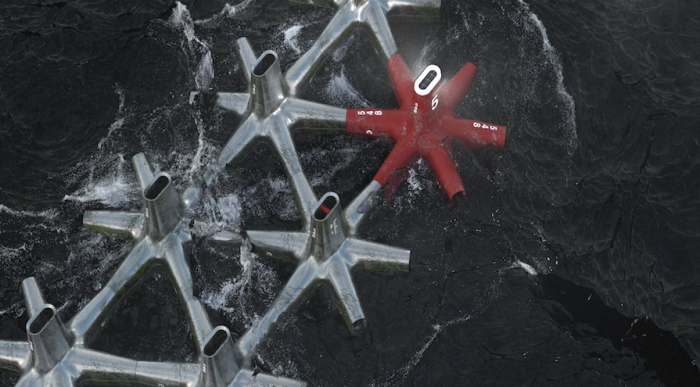Industrial designer Xavier Ouellet has developed a system of floating tetrapods that protects coastline from erosion. Working like a natural mangrove forest, the structures diffuse strong ocean currents before they hit the shores and reduce the impact on ecosystems and coastal communities. Ouellet’s system is named Aflot.
Inspired by Brutalism, Ouellet attempts to balance form and function. He wanted the geometric Aflot objects to be poetic as well as functional. The shapes are commanding, almost bullish, and yet they have a deliberate nautical appearance – a nod to their use and context.
Aflot was developed as a thesis project during Ouellet’s time at the School of Design at the University of Montreal. He has been selected to present his project as part of the 2020 antenna edition during Dutch Design Week.

We had the chance to ask Ouellet about how he thinks designers can impact the future and why they need to remember, COVID aside, that the climate crisis is probably the biggest emergency of our generation.
How do you think design can better be used as a tool for change?
Design is a tool that allows you to see situations as a whole, and it's essential to evolve for the better. When we design products there is the possibility (or the risk) that they will become widespread. So each design choice has the power to contain a positive change.
What are your design ethics?
I want to design objects that last over time. I sincerely believe that design holds all the power necessary to transform the world we live in and to respond to the crises that can strike our societies. We only have eyes for COVID right now, but the climate challenge certainly remains the greatest of our time. Design can be both a problem and a solution to this huge challenge.
I would also like to create objects that participate in the culture of Montreal design. I think our environment shines through a lot in who we are as a designer and I like to think that the reverse is also true, namely that we can have an impact on our environment.
Should products always be “useful”?
Seeing design as a practice that sits between art and utility, I would say no. That said, if we use design to express ourselves, to affect the collective imagination, I believe that just like art, expressive design finds a new utility, but more at the level of collective imagination and transformation.
What inspired your project?
Completing your education in a field that is known to have the potential to negatively contribute to the environmental crisis puts incredible pressure and responsibility on us. I wanted to use my education to take action on an issue that is very present near me. I very much like to think that this is a project that goes far beyond the object, which affects both society and the environment. The impact that such a project can have on individuals and communities is in itself extremely inspiring.
How can Aflot be deployed efficiently along coastlines?
The product has been designed to use as little material as possible, to be as compact as possible during transport and for quick installation on the shore. The modules that make up the floating structure can be dismantled and stacked for efficient and economical transportation to their destination.
That said, the project still requires to set up important infrastructure that demands the commitment of public authorities and communities if we ever hope to see it happen.
What are the major problems associated with coastal erosion?
The problem is that we are trying to fight erosion instead of trying to have resilient management. The artificialisation of the shores prevents the natural movement of the shores, it destroys the ecosystems which naturally protect the shoreline, which then makes floods and storms more and more dangerous for nearby infrastructures.
How does Aflot help protect the coastal ecosystem?
Mainly by its type of implantation on the ground. Having a floating structure, fixed by cables to the ground, keeps the ground in its natural state, which protects marine ecosystems. It protects both habitat and aquatic species. Also, in a roundabout way, the reduction in raw material as well as the choice of a recyclable material makes it a more sustainable solution than traditional concrete systems.
How useful are constraints in the design process and what were your main constraints with this project?
Conceptual constraints, such as the need to protect marine ecosystems, the need to alleviate the vulnerability of inhabitants of coastal communities, as well as the protection of road infrastructures were goals that definitively directed the project.
Were you forced to make any compromises?
My vision for the project at first was extremely focused on artistic expression and the desire to protect natural environments, while my mentor's vision was more focused on innovation, as much in the understanding of the physical principles that should guide the project as in the search for materials. Our conversations were a succession of compromises on both sides drawing the line between aesthetics, architectural references and the desire for innovation, among others.
What made you decide to study design?
It's a bit childish but I've always loved creating things, as far back as I can remember. I started my studies in architecture where I really understood how our conceptual decisions as creators can really influence the daily lives of the people who will inhabit what we design. My conceptual approach remains hugely influenced by my background in architecture.






